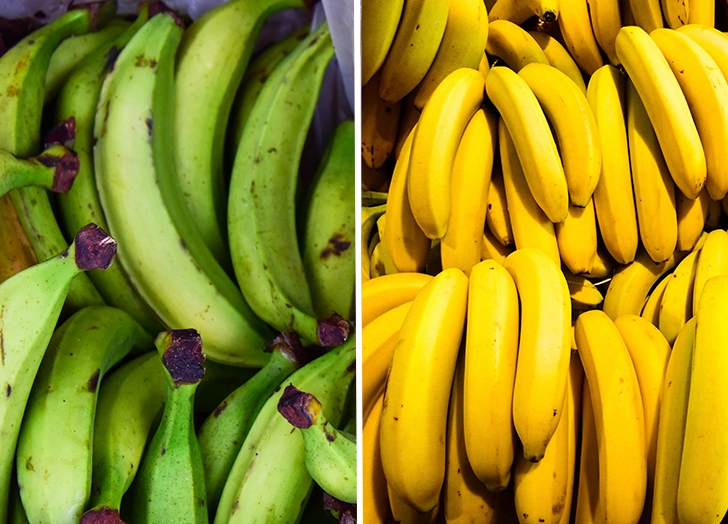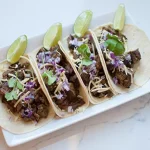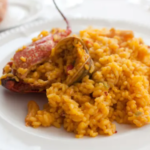Both the plantain and the banana are tropical fruits, very common in countries near the equator and the coasts, however, the rest of the world also knows and enjoy them. Although if you consume these fruits daily you probably won’t confuse them, surely you have ever wondered what the differences are between banana and plantain. Will both fruits have the same properties? Which is healthier, the plantain or the banana? If you want to clarify these doubts and know many more things about these fruits, we invite you to enjoy this article we brings to you.

Are the plantain and the banana the same?
Certainly, to the naked eye, both fruits appear almost identical. This is because they belong to the same family (the Musicale). However, if you investigate its qualities in detail, you will notice several important nutritional, organoleptic and taxonomic differences. Although these details seem small, they still count, so for you to draw your own conclusions, here we leave you the most important similarities and differences between plantains and bananas:
- They both have the same shape, but different sizes. Although both fruits have the same elongated shape, they differ in size. The plantain is larger and thicker, while the camber is smaller and thinner.
- The color is slightly different. It is important to mention that both the plantain and the banana turn from green to yellow and, finally, to black, during their ripening process. For reasons of distribution and consumption, the most common is to find green plantains, while bananas are usually yellow. The real difference between their colors can be seen when both are slightly ripe: the banana is bright yellow, while the plantain has an ocher-yellow hue.
- Both change their organoleptic characteristics as they mature, as well as transform their components and uses. In this way, both fruits change their uses in the kitchen, their sensory characteristics and their health benefits. For example, if you have diarrhea, you will surely feel better with a green banana soup. On the contrary, if you feel constipated, a ripe banana will stimulate your intestinal transit.
- They have different flavors and texture. While the banana has a sweeter flavor and a smooth texture; the banana has a less sweet flavor and a somewhat floury texture (in its early ripening stage). This difference is due to the fact that the banana has more starch and the banana has more sugar.
- The aroma also feels slightly different. If you bring your nose close to a bunch of bananas, its intense and sweet aroma will envelop you. However, if you do the same thing with the bananas, you will notice a very unromantic and perhaps earthy smell.
- Very similar nutritional contributions, but not the same. The banana contains carbohydrates, composed mainly of starches, as well as providing a greater amount of protein, fiber, potassium and sodium. For its part, the banana has carbohydrates composed mainly of sugars, it has more calories than the banana, and it contains a greater amount of micro minerals (iron, copper, zinc, manganese and others) and a greater amount of vitamin C.
- The skin of the plantain and the banana are different. Bananas have a smooth shell that you can easily peel with your hands. On the other hand, the banana has a thicker, firmer shell that is somewhat difficult to remove.
- Different culinary applications. A banana is usually served in desserts (ice cream, in cakes, muffins, etc.) or eaten plain and raw. For its part, the banana is used more for salty foods and, on some occasions; for desserts, but it is never eaten raw (it can make you indigestible). The banana is versatile in the kitchen, it is used in: soups (green), slices to accompany savory dishes (ripe), steamed (green or ripe), to stones (green), pat cones (green and penton), cakes (ripe), sweets etc.
Banana: properties and composition
The banana is one of the most popular and recognizable fruits, both for the benefits it brings to the body and for its sweet and delicious taste. Reasons are not lacking, because “the fruit of joy” is full of attributes that benefit those who consume it, surely you already know more than one:
- Fight constipation and stop diarrhea. A ripe banana favors intestinal transit (thanks to its sugar content), while a green one (boiled or steamed) controls diarrhea.
- Reduces blood pressure. This happens thanks to the potassium contained in bananas, which provides approximately 15% of the daily requirement of an adult.
- It provides group B vitamins. This vitamin complex provides energy to the body, protects the immune system and the nervous system.
- Decreases the acidity of the blood. Banana slows down acidosis and increases the alkaline reserves of the body.
- Soothes heartburn. A well-ripened banana, eaten before eating, neutralizes excess gastric acidity, thus protecting the stomach. It also decreases stomach pain.
- Avoid anemia or fatigue. Athletes and people who lead a fitness lifestyle consume a banana before, during and after training. In this way, they increase their resistance and facilitate muscle recovery.
Now, all these benefits are backed by the important nutritional value of the banana, since each 100 g of this fruit contains:
- Energy value: 110.15 Kcal
- Fiber: 2.3%
- Calcium: 12.5mg
- Magnesium: 41.5mg
- Iron: 0.9mg
- Copper: 0.3mg
- Zinc: 0.2mg
- Manganese: 0.1mg
- Vitamin C: 18.5mg
- Proteins: 0.3mg
- Potassium: 434mg
- Phosphorus: 59.1 mg
- Carbohydrates: 26.2%
Beyond bananas, there is also a species called Canadian banana, very famous in Spain and produced in the Canary Islands. It should not be confused with plantains, as Canadian plantains are sweet, small and can be eaten raw, just like bananas.
In addition to eating them alone, Canadian bananas and plantains can be used in endless healthy recipes and in delicious desserts; here are some recipes with bananas so you can enjoy all their properties, now that you know them:
- Banana cake
- Homemade banana ice cream
- Banana and oatmeal muffins
- Oatmeal Banana Pancakes
Banana: properties and composition
Compared to the banana, perhaps the properties of the banana are less well known and famous. However, in some aspects they are very similar, although I assure you that the banana has, up its sleeve, properties that may surprise you and that its relative does not have or has on a smaller scale.
- It is a prebiotic food. It generates retrograde starch, which passes intact through the digestive tract and reaches the intestinal flora to serve as food for microbes.
- Prevents hypertension. The male banana provides more potassium than bananas. For this reason, it balances excess sodium in the diet.
- It favors athletes and people who train. By providing abundant potassium and magnesium, it prevents cramps and restores electrolytes.
- Control diabetes. A green banana, steamed or boiled, produces retrograde starch, which passes intact through the digestive tract and does not produce increases in blood glucose.
- Fight gastritis. It relieves the sensation of acidity, as well as the sensation of stomach burning. It also prevents gas and indigestion.
- It favors healing processes. Remarkably improves both internal wounds (gastric mucosa) and external wounds (wounds or burns) in the body. For internal wounds, it is consumed in powder form (very common in India), and for external wounds, the powder or the pulp of the fruit is applied. In cases of mosquito bites, the inner part of the shell is used and rubbed on the injury.
Where do so many qualities come from? This is the nutritional value of the banana for every 100 g of the fruit:
- Energy value: 96.4 Kcal
- Fiber: 2.5%
- Calcium: 7.8mg
- Magnesium: 38.5mg
- Iron: 0.3mg
- Copper: 0.1mg
- Zinc:2mg
- Manganese: 0.1mg
- Vitamin: C 17.5mg
- Proteins: 1.7mg
- Potassium: 490mg
- Phosphorus: 59.1 mg
- Carbohydrates: 22.5%
The banana is a fundamental part of Latin American gastronomy, as can be seen in the most typical dishes of Colombia and the most typical dishes of Venezuela. If you want to know more recipes with plantains, you cannot miss these:
- Venezuelan to stones
- Colombian aborrajadas
- Green plantain fries
What is healthier: the plantain or the banana?
Before announcing a resounding tie between both fruits, we will argue the reason for this decision. If bananas and plantains are so similar, especially when it comes to nutrients, it stands to reason that they provide almost the same benefits. Therefore, both fruits are equally healthy (their uses and properties in the body are very similar).
However, there are important details to consider about the composition of both fruits that may be more related to the individual needs of each organism. For example, bananas have more starch and bananas contain more sugar. For a diabetic, a green banana (boiled) will be healthier than a very ripe banana. So which one would be healthier for you?
What is more fattening: the plantain or the banana?
If we were guided by the amount of calories and the nutritional content, we could conclude that bananas are more fattening than bananas and that, in addition, they contain more sugars than the latter. However, it is important to note that the caloric content is not particularly high, so neither of these two fruits is considered harmful for people looking to lose weight. On the contrary, both are highly nutritious fruits that can help us lose weight.
Of course, they will be more or less healthy depending on how we prepare them. A fried banana will always bring more calories and fat than a boiled one. In the same way, sweets made with bananas will contain even more sugars than pure, raw bananas.
Tip: All fruits are healthy, none is better than another, but they are used for different things.



